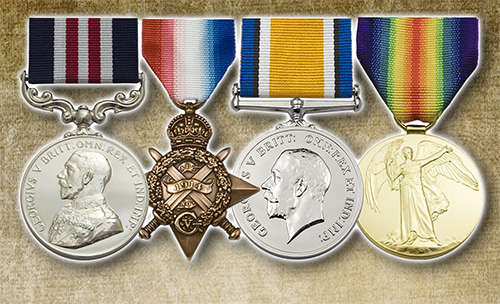Guide to the orders & Medals awarded in the Great War
The aim of this Medal tutorial is to help aid you with your genealogy search and understanding of the British and Commonwealth Campaign and Gallantry Medals awarded during the Great War of 1914-18.
For over 200 years Campaign Medal awards have marked the wars, battles, conflicts and campaigns fought by British and imperial forces across the world. It should be remembered that some of these campaign medals, especially the WWI medals, commemorate service in some of the bloodiest battles ever fought by British and Commonwealth forces in history.
After World War One, campaign medals were issued on a grand scale never seen before. Millions of servicemen who served in the British military during the War were entitled to at least one medal for being there. Nearly five million men passed through the British Army from 1914-18, though men who were stationed in the UK were not entitled to a medal, yet any who served abroad were. Also, there was a grand number of civilian, nursing and Para-military personnel that were entitled to a medal.
It was intended that older medal traditions be followed and award the medals in silver with battle or operation clasps. The Army had many proposals, these totalled 79 and the Navy 68, though it was deemed to be complicated to work out who had earned what clasp and also to be too costly, so this idea was abandoned. Instead, it was decided that general War medals would be awarded and that all eligible personnel regardless of service branch or theatre of war would be given the same medal. In the end, only seven different campaign medals were issued for service in World War One, these being the bronze 1914 and 1914-18 Star, the Silver British War Medal, the gilt-washed Victory medal, the bronze Mercantile Marine War Medal and the Territorial Force War Medal. The only clasp awarded in these campaign medals of World War One was one dated ‘5th AUG.-22nd NOV. 1914’ that was to be attached to the ribbon of the 1914 Star and awarded to those who had operated within the range of enemy mobile artillery during the above period.
‘Below is a basic guide to most of the Great War era medals that people will find’
NOTE: ‘British gallantry and bravery awards of the First World War’ – If the military ancestor you are researching won such an award, your chances of finding something about his service from the announcements are very good. The award of gallantry and bravery medals was always notified in the “London Gazette” and often recorded in the serviceman’s Unit War Diary. The London Gazette records are now online and searchable via Forces War Records HERE.
‘British gallantry and bravery awards of the First World War’
Victoria Cross (V.C.)
Post-nominal entitlement: V.C
Instituted: 29th January 1856
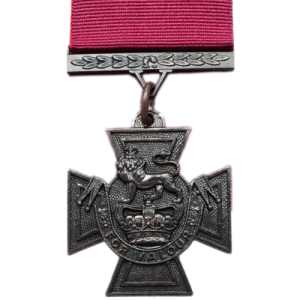
The Victoria Cross (VC) is the highest military decoration awarded for valour “in the face of the enemy” to members of the armed forces of various Commonwealth countries, and previous British Empire territories.
It takes precedence over all other orders, decorations and medals.
It may be awarded to a person of any rank in any service and to civilians under military command.
The VC is usually presented to the recipient or to their next of kin by the British monarch at an investiture held at Buckingham Palace.
The VC was introduced on 29th January 1856 by Queen Victoria to honour acts of valour during the Crimean War. Since then, the medal has been awarded 1,358 times to 1,355 individual recipients.
Queen Victoria had instructed the War Office to strike a new medal that would not recognise birth or class. The medal was meant to be a simple decoration that would be highly prized and eagerly sought after by those in the military services.
To maintain its simplicity, Queen Victoria, under the guidance of Prince Albert, vetoed the suggestion that the award be called The Military Order of Victoria and instead suggested the name Victoria Cross. The original warrant stated that the Victoria Cross would only be awarded to soldiers who have served in the presence of the enemy and had performed some signal act of valour or devotion.
The Original Warrant Clause 1 states that the Victoria Cross “shall consist of a Maltese cross of bronze”.
Nonetheless, it has always been a cross pattée; the discrepancy with the Warrant has never been corrected.
On 22nd May 1920 King George V signed a warrant that stated all recipients would now receive a red ribbon and the living recipients of the naval version were required to exchange their ribbons for the new colour.
Although the Army warrants state the colour as being red it is defined by most commentators as being crimson or “wine-red”
The Victoria Cross is awarded for
… most conspicuous bravery, or some daring or pre-eminent act of valour or self-sacrifice, or extreme devotion to duty in the presence of the enemy.
A recommendation for the VC is normally issued by an officer at regimental level, or equivalent, and has to be supported by three witnesses, although this has been waived on occasion.
The recommendation is then passed up the military hierarchy until it reaches the Secretary of State for Defence.
The recommendation is then laid before the monarch who approves the award with his or her signature.
Victoria Cross awards are always promulgated in the London Gazette with the single exception of the award to the American Unknown Soldier in 1921.
The awards were mentioned in notices in the Gazette dating back to the Indian Mutiny. The Victoria Cross warrant was not amended to explicitly allow posthumous awards until 1920, but one-quarter of all awards for World War I were posthumous.
In the case of a gallant and daring act being performed by a squadron, ship’s company or a detached body of men (such as marines) in which all men are deemed equally brave and deserving of the Victoria Cross then a ballot is drawn. The officers select one officer, the NCOs select one individual and the private soldiers or seamen select two individuals.
Due to its status, the VC is always the first decoration worn in a row of medals and it is the first set of post-nominal letters used to indicate any decoration or order.
There were 615 Victoria Crosses awarded during the First World War. WW1 awards of the Victoria Cross were:
- 415 awarded to the British Army
- 140 to the Dominion Forces.
- 51 to the Navy and Marines
- 9 to the Royal Flying Corps and Royal Air Force
Distinguished Service Order (D.S.O.)
Post-nominal entitlement: D.S.O.
Instituted: 6th September 1886
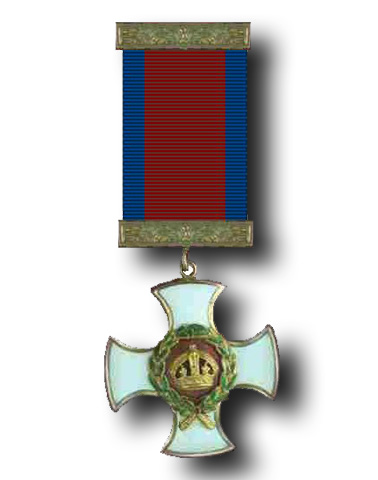
Instituted on 6th September 1886 by Queen Victoria in a Royal Warrant the Distinguished Service Order (DSO) is a military decoration of the United Kingdom, and formerly of other parts of the Commonwealth. The first DSOs were awarded on 25th November 1886 for meritorious or distinguished service by officers of the armed forces during wartime, typically during actual combat against the enemy.
In terms of prestige, the Distinguished Service Order (DSO) was regarded as somewhat lesser than a Victoria Cross and recipients were also entitled to use the post-nominals letters DSO after their name with each award being announced in the London Gazette.
The Distinguished Service Order was a military order, until recently for officers only, and normally given for service under fire or under conditions equivalent to service in actual combat with the enemy, although it was awarded between 1914 and 1916 under circumstances which could not be regarded as under fire (often to staff officers, which caused resentment among front-line officers). After 1st January 1917, commanders and officers in the field were issued guidance stating that the award was reserved for distinguished conduct under enemy fire. Prior to 1943, the order could be given only to someone specifically Mentioned in Despatches by the Commander-in-Chief.
During the First World War, 8,981 DSOs were awarded, each award being announced in The London Gazette together with its accompanying citation.
The order is generally given to officers in command, above the rank of captain. A number of more junior officers were awarded the DSO, and this was often regarded as an acknowledgement that the officer had only just missed out on the award of the Victoria Cross. In September 1942, the regulations were relaxed to permit the award of the DSO to officers of the Merchant Navy who had performed acts of gallantry in the presence of the enemy.
Distinguished Service Cross (D.S.C.)
Post-nominal entitlement: D.S.C
Instituted: 15th June 1901
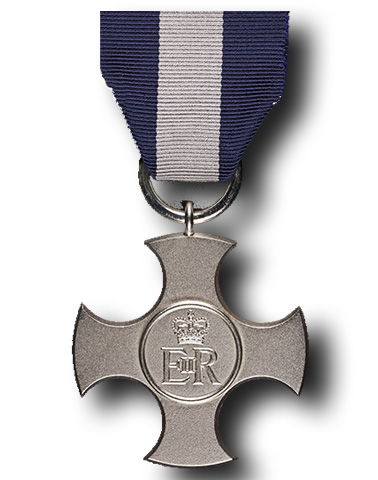
The Distinguished Service Cross (DSC) was awarded to officers, and since 1993 other ranks of the British Merchant Navy, Royal Fleet Auxiliary and British Armed Forces and officers of the Commonwealth.
The award was originally established in 28th June 1901 by King Edward to “recognize meritorious or distinguished services before the enemy” and known as the Conspicuous Service Cross and awarded to Warrant and subordinates officers of the Royal Navy who were eligible for the Distinguished Service Order (DSO). In October 1914 it was renamed the Distinguished Service Cross and eligibility extended to all naval officers (commissioned and warrant) below the rank of Lieutenant Commander. Bars for the performance of further acts of gallantry meriting the award were authorised in 1916.
The Distinguished Service Cross (DSC), which may be awarded posthumously, is granted in recognition of “… gallantry during active operations against the enemy at sea.”
A bar is awarded for subsequent acts of gallantry. The recipient is entitled to use D.S.C. after their name.
Almost 2,000 D.S.C.s were awarded during the First World
Military Cross (M.C.)
Post-nominal entitlement: M.C.
Instituted: 28th December 1914
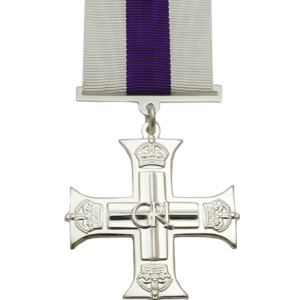
The Military Cross (MC) was created on 28th December 1914 for commissioned offers of the substantive rank of Captain or below and for Warrant officers. It was instituted shortly after the outbreak of the Great War of 1914-18 as there were no gallantry awards lesser than the Victoria Cross and the Distinguished Service Order, for junior Army officers and Warrant officers.
The award is a third-level military decoration.
The Military Cross (MC) is granted in recognition of “an act or acts of exemplary gallantry during active operations against the enemy on land to all members, of any rank in Our Armed Forces.” Bars were awarded to the MC in recognition of the performance of further acts of gallantry meriting the award and recipients of a bar continue to use post-nominal letters M.C. Bars are plain silver with the imperial crown in the centre. The cross is issued unnamed but recipients often have their names engraved on the reverse of the cross. Notification of the award is always published in the London Gazette and often contains a citation of the circumstances of the action as well as details of the recipient.
Distinguished Flying Cross (D.F.C.)
Post-nominal entitlement: D.F.C.
Instituted: 3rd June 1918
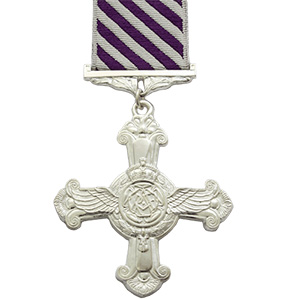
Established on June 3rd, 1918, the birthday of King George V the Distinguished Flying Cross (DFC) is awarded to personnel of the United Kingdom’s Royal Air Force (RAF) and other services, and formerly to officers and Warrant officers of other Commonwealth countries, instituted for “an act or acts of valour, courage or devotion to duty whilst flying in active operations against the enemy”.
The award was established shortly after the formation of the RAF. It was originally awarded to air force commissioned officers and to Warrant Officers.
A bar is added to the medal ribbon for subsequent acts of valour, for which a subsequent D.F.C. would be awarded. Recipients of the medal are entitled to use the letters D.F.C. after their name. The medal was issued with no inscription of the recipient’s name.
During the First World War, there were about 1,100 D.F.C. awards.
It is equivalent to the Distinguished Service Cross (D.S.C) for acts of valour at sea and the Military Cross (M.C.) for acts of valour on land.
Air Force Cross (A.F.C.)
Post nominal entitlement: A.F.C.
Instituted: 3rd June 1918
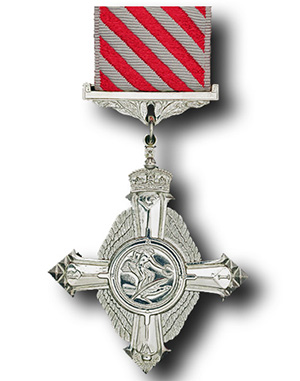
The Air Force Cross (AFC) was first established by King George V on the 3rd June 1918, after the formation of the RAF. It is a military decoration awarded to personnel of the United Kingdom Armed Forces, and formerly also to officers of the other Commonwealth countries, for “an act or acts of valour, courage or devotion to duty whilst flying, though not in active operations against the enemy”. It may also be granted to individuals not belonging to the RAF for having rendered distinguished services to aviation in actual flying.
It was originally awarded to Air Force commissioned officers and Warrant Officers, but this was expanded after the Second World War to include Army and Navy aviation officers, and again in 1993 to other ranks after the review of gallantry awards and the discontinuation of the Air Force Medal.
During the First World War, approximately 680 were awarded. During the Second World War, 2,001 decorations were awarded, with 26 bars awarded.
Recipients of the Air Force Cross are entitled to use the post-nominal letters “AFC”. A bar is added to the ribbon for holders of the AFC who received a second award. The bar has an eagle in the centre and the year of the award is engraved on the reverse.
The AFC was essentially a non-combat version of the Distinguished Flying Cross.
Distinguished Conduct Medal (D.C.M.)
Post-nominal entitlement: D.C.M
Instituted: 4th December 1854
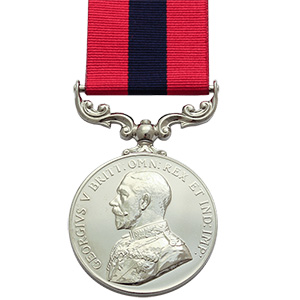
The Distinguished Conduct Medal (DCM) was (until 1993) an extremely high-level award for bravery. It was a second level military decoration awarded to other ranks of the British Army and formerly also to non-commissioned personnel of other Commonwealth countries. Recipients are entitled to the post-nominal letters DCM and were announced in the London Gazette, accompanied by a citation.
The medal was instituted by Royal Warrant on 4th December 1854, during the Crimean War, to recognise gallantry within the other ranks, for which it was equivalent of the Distinguished Service Order (DSO) awarded for bravery to commissioned officers, but the DCM ranked well below the DSO in precedence. Prior to the institution of this decoration, there had been no medal awarded by the British government in recognition of individual acts of gallantry in the Army.
Although the Distinguished Conduct Medal remained available the lesser Military Medal was usually awarded from the spring of 1916 other than for exceptional acts of bravery.
The D.C.M. was discontinued as an award by the British Armed Forces in 1993, when the three awards of the D.S.O, the D.C.M. and the C.G.M. were replaced by the Conspicuous Gallantry Cross. The Conspicuous Gallantry Cross is now the second level gallantry award for all ranks of the British Armed Forces.
Conspicuous Gallantry Medal (C.G.M.)
Post-nominal entitlement: G.C.M
Instituted: 7th July 1874. (discontinued in 1993).
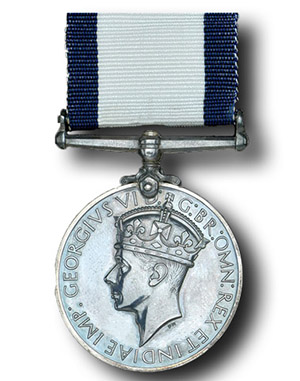
Instituted by Royal Warrant on 7 July 1874, the Conspicuous Gallantry Medal (CGM) was awarded to non-commissioned officers and men of Britain and her Empire for conspicuous gallantry in action against the enemy at sea or in the air. The medal was the other ranks’ equivalent of the Distinguished Service Order (DSO) and was ranked between the British Army’s Distinguished Conduct Medal (DCM) and the Distinguished Service Medal (DSM) in terms of prestige.
The reverse of the medal bears the inscription “For Conspicuous Gallantry”. An additional award for a subsequent deed would entitle the wearer to a silver laurelled bar. A recipient of the award is entitled to use the letters C.G.M. after their name.
The C.G.M. is equivalent to the British Army’s Distinguished Conduct Medal (D.C.M.)
Distinguished Service Medal (D.S.M.)
Post-nominal entitlement: D.S.M
Instituted: 14th October 1914
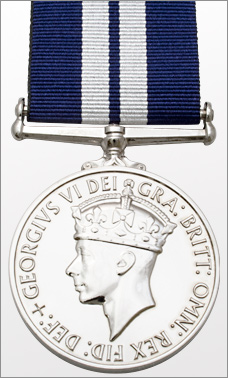
The Distinguished Service Medal (DSM) was established on 14th October 1914 and awarded to petty officers and ratings of the Royal Navy, NCOs and other ranks in the Royal Marines and all other persons holding corresponding ranks or positions in the naval forces, who “show themselves to the fore in action, and set an example of bravery and resource under fire, but without performing acts of such pre-eminent bravery as would render them eligible to receive the Conspicuous Gallantry Medal (CGM)”.
The DSM was the other ranks’ equivalent to the Distinguished Service Cross, the DSM was awarded to approximately 4,100 individuals during World War One. A Bar was sanctioned in 1916 for each further acts of bravery undertaken by existing holders, with two individuals receiving two Bars and 67 being issued with one Bar. All awards of the DSM were notified in The London Gazette, however, apart from very early on, few citations were published.
Military Medal (M.M.)
Post-nominal entitlement: M.M.
Instituted: 25th March 1916
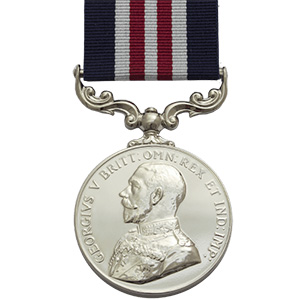
Instituted by Royal Warrant on 25th March 1916, and subsequently backdated to August 1914, the Military Medal was awarded to warrant officers, non-commissioned officers and men of the British Army and Commonwealth Forces to recognise acts of bravery in the field.
The Military Medal was the other ranks’ equivalent to the Military Cross (MC), (which was awarded to commissioned officers and, rarely, to Warrant Officers, although WOs could also be awarded the MM). The MM ranked below the MC and the Distinguished Conduct Medal (DCM), which was also awarded to non-commissioned members of the Army.
Recipients of the Military Medal are entitled to use the post-nominal letters “MM” and awards were notified in the London Gazette, usually within four months of the action, however, citations were very rare.
As many as 115,000 Military Medals were awarded during the Great War 1914-18, along with over 5,000 first bars, 180 second bars and 1 third bar.
The Distinguished Flying Medal
Post-nominal entitlement: D.F.M
Instituted: 3rd June 1918
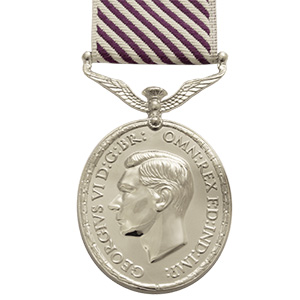
The Distinguished Flying Medal (DFM) was instituted by Royal Warrant on 3 June 1918. It was awarded to other ranks of the Royal Air Force for an act or acts of valour, courage or devotion to duty while flying on active operations against the enemy. Later it was available to the equivalent ranks in the Army and Royal Navy for acts of valour in the air.
Recipients of the medal are entitled to use the letters D.F.M. after their name. A subsequent award receives a silver bar with an eagle in the centre of it.
Issued to just 104 recipients during World War One, the DFM was the equivalent of the Military Medal (MM) for acts of valour on land, the Distinguished Service Medal (DSM) for acts of valour at sea, and the Air Force Medal (AFM). All recipients of the medal were entitled to use the letters DFM after their name.
The Air Force Medal (A.F.M.)
Post-nominal entitlement: A.F.M
Instituted: 3rd June 1918
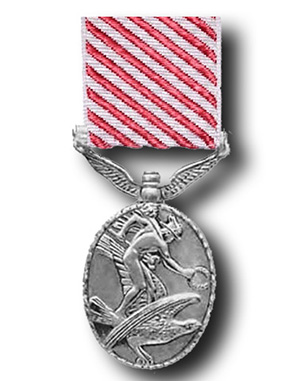
The Air Force Medal (AFM) was instituted on 3 June 1918 and was awarded to British and Commonwealth forces below commissioned rank for ‘an act or acts of valour, courage or devotion to duty whilst flying, though not in active operations against the enemy.’ The other ranks’ equivalent of the Air Force Cross (AFC).
Recipients of the Air Force Medal are entitled to use the post-nominal letters “AFM” and a straight slip-on silver bar is awarded for a further acts that would have warranted the medal. The year of the award is engraved on the back of the bar.
Meritorious Service Medal (M.S.M.)
Post-nominal entitlement: M.S.M
Instituted: Instituted in 1845 (British Army), in 1849 (the Royal Marines), in 1918 (the Royal Air Force) and in 1919 (the Royal Navy).
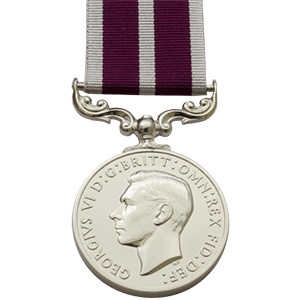
The Meritorious Service Medal was originally awarded to warrant officers and sergeants of the British Army and Royal Marines in recognition of long and meritorious service; from 1917 it was also for gallantry or meritorious service when not in face of the enemy. The following year, a version for the Royal Air Force was instituted for meritorious service not involving flight. The latter awards (“Immediate MSM’s”) were announced in the London Gazette. The recipient was allowed to use the letters MSM after their name.
Mentioned in Despatches (M.I.D.)
Established: 1919
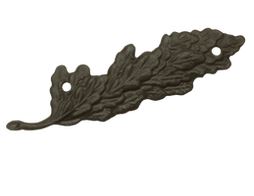
“Mentioned in Despatches” is not an award of a medal, but as a commendation of an act of gallantry, it is included in this guide.
A soldier mentioned in dispatches (or despatches) (MID) is one whose name appears in an official report written by a superior officer and sent to the high command, in which is described the soldier’s gallant or meritorious action in the face of the enemy.
In the British Armed Forces, the despatch is published in the London Gazette.
Soldiers of the British Empire or the Commonwealth of Nations who are mentioned in dispatches but do not receive a medal for their action are nonetheless entitled to receive a certificate and wear a decoration. For 1914-1918 and up to 10th August 1920, the decoration consisted of a spray of oak leaves in bronze.
The MID oak leaf is normally attached and worn on the appropriate campaign medal ribbon, for WWI this is normally the Victory Medal.
NOTE: ‘British Campaign Medals of World War One’ – There were five campaign medals available for individuals from Britain and her Dominions who served in an operational theatre during World War One. Of these five, recipients were usually eligible for a maximum of three medals, although there are a small number of exceptions to the rule. The most common combination of medals was the British War Medal and Allied Victory Medal pair, followed by the 1914-15 Star, the British War Medal and the Allied Victory Medal trio – often referred to by the nickname ‘Pip, Squeak and Wilfred’. The medals’ nicknames come from a popular comic strip of the time from the Daily Mirror newspaper. Pip was a dog, Squeak a penguin and Wilfred was a baby rabbit. In addition to the five campaign medals, service personnel who had been honourably discharged due to wounds or sickness could also be awarded the Silver War Badge.
The 1914 Star
Established in April 1917.
The 1914 Star, also known as ‘Pip’ or the ‘Mons Star’.
This Bronze Star was authorised in April 1917, to be awarded to those who served in France or Belgium on the strength of a unit, or service in either of those countries between 5th August and midnight on 22nd/23rd November 1914. The former date is the day after Britain’s declaration of war against the Central Powers, and the closing date marks the end of the First Battle of Ypres.
Recipients were officers and men of the pre-war British army, specifically the British Expeditionary Force (the Old Contemptibles), who landed in France soon after the outbreak of the War and who took part in the Retreat from Mons (hence the nickname ‘Mons Star’). 365,622 were awarded in total. Recipients of this medal also received the British War Medal and Victory Medal. These three medals were sometimes irreverently referred to as Pip, Squeak and Wilfred.
The 1914-15 Star
Established – December 1918
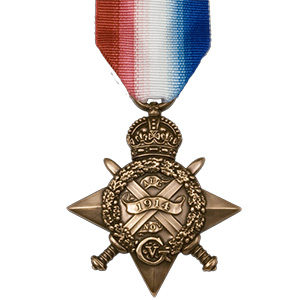
This Star, also known as ‘Pip’ is identical with the 1914 Star in every respect except that the centre scroll bears the dates “1914- 15” and the two small scrolls bearing “Aug” and “Nov” are omitted.
The 1914-15 Star was approved in 1918, for the issue to officers and men of British Imperial Forces who saw service in any theatre of war against the Central Powers between 5th August 1914, and 31st December 1915, except those eligible of the 1914 Star. Similarly, those who received the Africa General Service Medal or the Sudan 1910 Medal were not eligible for the award.
Recipients of this medal also received the British War Medal and Victory Medal – it was never awarded singly. The recipient had to have received the British War Medal and the Victory Medal. The reverse is plain with the recipient’s service number, rank, name and unit impressed on it.
An estimated 2.4 million of these medals were issued.
The British War Medal, 1914-18
Established on 26th July 1919
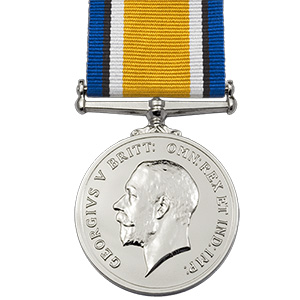
The British War Medal, also known as ‘Squeak’ was approved in 1919, for the issue to officers and men of British and Imperial forces who had rendered service between 5th August 1914 and 11th November 1918. Officers and men of the Royal Navy, Royal Marines, and Dominion and Colonial naval forces (including reserves) were required to have completed 28 days mobilised service – the medal was automatically awarded in the event of death on active service before the completion of this period.
The medal was later extended to cover and award the services in the period 1919–20 for mine-clearing at sea as well as participation in operations in North and South Russia, the eastern Baltic, Siberia, the Black Sea, and the Caspian.
This medal was issued singly without the Allied Victory Medal to certain regular and mobilized personnel who did not see any fighting.
Approximately 6.5 million British War Medals were issued. Approximately 6.4 million of these were the silver versions of this medal. Around 110,000 of a bronze version were issued mainly to Chinese, Maltese and Indian Labour Corps. The recipient’s service number, rank, name and unit were impressed on the rim.
Allied Victory Medal
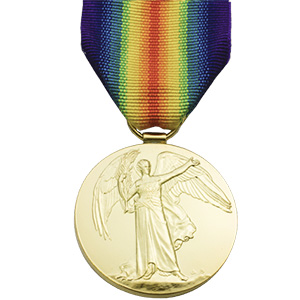
The Victory medal (also called the Inter-Allied Victory Medal and known as ‘Wilfred’) is a medal that was awarded to all who received the 1914 Star or 1914-15 Star and, with certain exceptions, to those who received the British War Medal. It was never awarded alone. These three medals were sometimes irreverently referred to as Pip, Squeak and Wilfred. However, in general, all recipients of ‘Wilfred’ also received ‘Squeak’ and all recipients of ‘Pip’ also received both ‘Squeak’ and ‘Wilfred’.
The design and ribbon were also adopted by Belgium, Brazil, Cuba, Czechoslovakia, France, Greece, Italy, Japan, Portugal, Romania, Siam, Union of South Africa and the USA in accordance with the decision of the Inter-Allied Peace Conference at Versailles (a ‘Winged Victory).
To qualify for the Victory Medal recipients had to be mobilised for war service in the United Kingdom or the British Empire, in any service, and to have entered a theatre of war between 5 August 1914 and 11 November 1918. Women qualified for this and the earlier two medals, for service in nursing homes and other auxiliary forces.
It was also awarded to members of the British Naval mission to Russia 1919 – 1920, and for mine clearance in the North Sea between 11 November 1918 and 30 November 1919.
Approximately 5.7 million victory medals were issued. The recipient’s service number, rank, name and unit was impressed on the rim.
Territorial Force War Medal
Established in April 1920
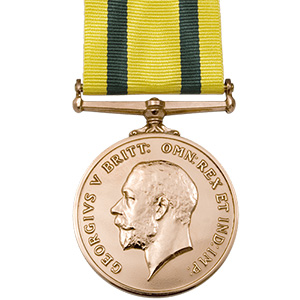
The Territorial Force War Medal was awarded to all members of the British Territorial Force, including Nursing Sisters (Territorial Force Nursing Services). They had to have been a member of the Territorial Force on or before 30th September 1914 and to have served in an operational theatre of war outside the United Kingdom between 5th August 1914 and 11th November 1918. In total 33,934 medals were awarded and it is the rarest of the five WWI campaign medals.
An individual who was eligible to receive the 1914 Star or 1914/15 Star could not receive the Territorial War Medal.
Mercantile Marine War Medal
Established in 1919
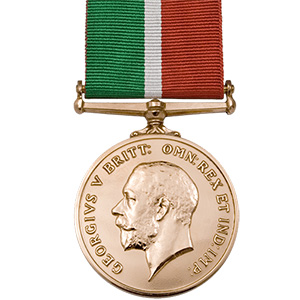 Issued by the Board of Trade to commemorate the war services of the officers and men of the Mercantile Marine, as the Merchant Navy was then called, who served one or more voyaged through a danger zone. It was given in bronze only to officers and men alike.
Issued by the Board of Trade to commemorate the war services of the officers and men of the Mercantile Marine, as the Merchant Navy was then called, who served one or more voyaged through a danger zone. It was given in bronze only to officers and men alike.
Men who were transferred in or out of the Mercantile Marine to or from fighting services would have the entitlement to the Victory Medal and sometimes the 1914 or 1914-15 Star if appropriate, and still be eligible for the Mercantile Marine War Medal.
The green and red colours of the ribbon represent the starboard and port running lights of a ship with the centre white colour being representative of the masthead steaming light. The green to be the left facing the wearer.
133,135 Mercantile Marine War Medals were awarded.
Silver War Badge
Issued on 12th September 1916
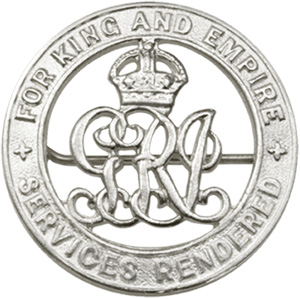
First issued in 1916 and continuing to 1920-22, the Silver War Badge, also known as the Services Rendered Badge, Discharge Badge or Wound Badge, was therefore issued to service personnel who had been honourably discharged due to wounds, disability or sickness (caused otherwise than by misconduct).
The causes of discharge are found in paragraph 392, Kings Regulations 1912, which lays down twenty-nine different possibilities.
The recipient would also receive a certificate with the badge. The badge was made of Sterling silver and was intended to be worn on the right breast of a recipient’s civilian clothing. It could not be worn on a military uniform.
It is stated that between 1916 and 1922 somewhere in the region of 1,150,000 badges were issued to service personnel, with each one being individually numbered on the reverse, thus making it possible to trace the recipient if the badge was lost and subsequently handed in to a Police station, though if it was permanently lost or stolen the War Office made it clear that they wouldn’t replace it. The individual numbering on the reverse of the badge also makes it possible to trace the recipients through the forces War Records Medal Roll records series WO329, so that if a service record has been lost, a record of the Silver War Badge may be the only remaining evidence of service. Search the silver War Badge 1914-20 records here
Find out more about your ancestors…
As well as records concerning World War One, Forces War Records also hold databases on World War Two, The Crimean War, Boer War, African Wars, Indian Mutiny, and the Napoleonic Wars (including Waterloo and Trafalgar). You can also search medal rolls, individual battle data and Prisoner of War Records, Royal Marines Databases, Fighter & Bomber Command Losses, and Fleet Air Arm Data among lots more.
